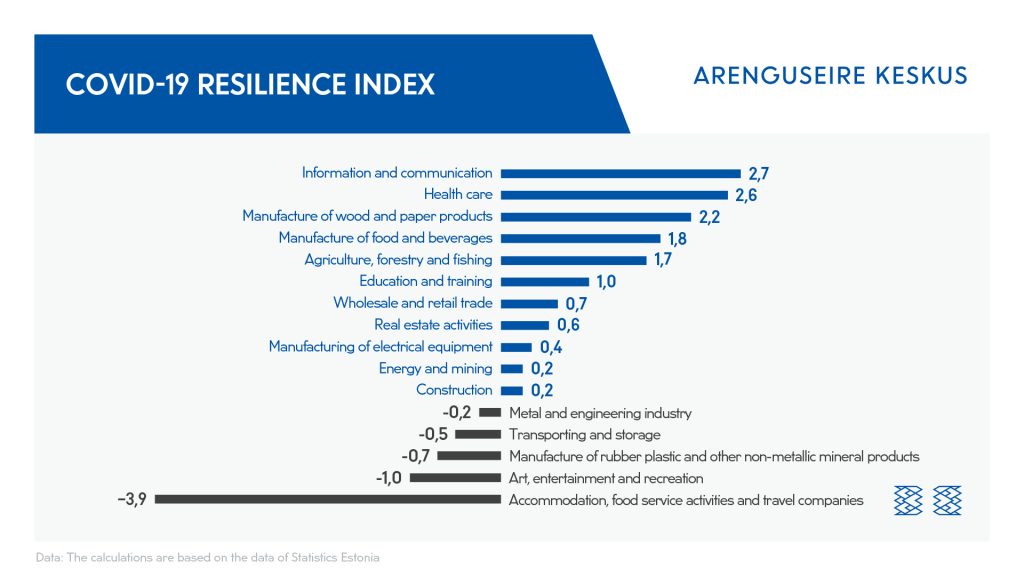The pandemic calls for innovations in risk management and cyber security in the financial sector
The low-interest rates embolden people to look for riskier investment opportunities, which in turn increases expectations on the risk management of financial institutions to avoid jeopardising the savings of private individuals, says the Foresight Centre report “The Impact of the Virus Crisis on the Estonian Economy. Scenarios up to 2030”. Banks have again started to fund the investments of businesses with more confidence.

“Compared to the economic crisis 10 years ago, the financial sector has suffered relatively little from the virus crisis. Despite the uncertainty caused by the pandemic, only a relatively small percentage of businesses and private individuals wished to change their loan payment schedules during the first wave of the virus crisis, and the housing loan market also ground to a halt for a short time only,” said Uku Varblane, Expert of the Foresight Centre. “Businesses are gradually regaining their risk-taking courage, the postponed investments are continued, and the banks also dare to finance these.”
Varblane explained that the financial technology companies that are springing up next to traditional banking would become much more visible over the upcoming years. “These have increased their market share during the virus crisis also by offering services to individuals and businesses neglected by the traditional banks,” he said.
For the insurance sector, the effect of the first wave of the crisis has been more multifaceted. “For example, with the travel restrictions in place, people no longer needed travel insurance, and the businesses that specialised on this segment felt the impact very keenly. On the other hand, the activities and volumes of life insurance companies were not affected very much; if anything, the demand for their services only grew,” Varblane noted.
Another pivotal change caused by the pandemic in the financial and insurance sector concerns people being encouraged to telework and the development of online services. “Product development is driven by the need to offer people more convenient remote and digital solutions. The rapid development of web-based channels is particularly visible in insurance, where it is becoming increasingly rarer to have brick and mortar offices,” Varblane said.
The preference for virtual services further highlights the aspects of cybersecurity in the financial sector. “For example, a more contact-free economy has led to an increased demand for insurance against cyber risks,” Varblane explained.
The future of the financial sector will be affected by the green transition. “Increasing capital volumes are seeking green economy projects, which in turn requires specific risk models and regulations,” Varblane added.
The financial and insurance sector employed 2.2% of the labour force, or 11,200 people, in 2019; the importance of the sector in the added value of the Estonian economy was 4.5%, or EUR 1.1 billion.
The monthly revenue of the businesses in the financial and insurance sector declined by 4.4%, or EUR 87.6 million, from March until October this year, compared to the year earlier.
BACKGROUND
The calculations and figures of the studies use the data of Statistics Estonia. The descriptions of development perspectives are based on the interviews with the representatives of sectoral associations and the focus group interviews conducted in cooperation with the research group of the Estonian Qualifications Authority OSKA. Read more here.
The Foresight Centre is a think tank at the Chancellery of the Riigikogu that analyses long-term developments in society and economy. The Centre conducts research projects to analyse long-term developments in the Estonian society and to identify new trends and development directions.
Latest news
-
10.11 2025Report: Estonia could learn how to control healthcare costs from the Netherlands
The expenses of the Estonian Health Insurance Fund significantly exceed its revenues, and the accumulated reserves will be depleted in the next five years. Other European countries in the same situation have cut healthcare services and increased people’s co-payments. According to the Foresight Centre’s new short report “Other countries’ experiences in managing healthcare budget deficits”, both solutions have worsened public health and deepened inequality.

 An independent think tank at the Riigikogu
An independent think tank at the Riigikogu 